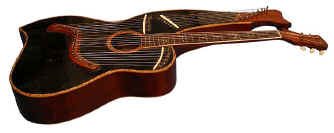
Knutsen Zither Harp Guitar
In a word - unbelievable!
This guitar was happily traded off by a player who didn't think it was
"restorable" - as it had so many extra added tuning pins and holes
drilled in it. The recipient was Knutsen expert Kerry Char (who has graciously made
it available for my collection).
What Kerry soon suspected and quickly verified, however, was that the instrument
was completely original!
This is not Knutsen's standard Lower Bass Point, Short Arm harp guitar (which it
is in body and arm style). Instead of extra bass strings, it has three
banks of extra treble strings! With seven in each, plus the 6-string neck,
that's 27 strings.
As all are roughly the same scale, Kerry and I couldn't figure out why there
would be three similar treble sections. Normally, we assume Knutsen's treble
strings to have been strung high, and tuned to a scale. But when Kerry described
the original strings still remaining on the two lowest banks, it made sense. The
shortest strings of each 7-string section were light gauge steel, but became
gradually thicker up to the longest string - which was a very heavy wound string
(.070" on one!).
Thus the obvious answer: the three short 7-string banks weren't tuned to scales, they were tuned to
chords! And obviously, three different specific
chords. In essence, a harp guitar seemingly influenced by the "chord
group" variety of fretless zithers, so common in America at the time (see
Fretless
Zithers on my main site for more on these instruments). Looking like
a harp guitar, but played in some new zither or "autoharp"-like
fashion - who dreamt this up? Knutsen? An even more eccentric customer?
Of course, the bass headstock and bridge shape are very
different to ingeniously accommodate the three low-to-high groups of strings.
Evidence that the chord string banks were not added by someone later was inside the
guitar. All the tuning pins and bridge holes have original-looking support
plates glued under the top. And they are of such length that they couldn't have
been inserted through the soundhole later, but would have to be constructed
along with the guitar from the beginning.
Another Chris Knutsen masterpiece of creativity, originality and accomplishment.
Click on a picture to
enlarge
(images copyright Gregg Miner)
|
Knutsen Archives Inventory Number |
HGS40 |
|
|
Category |
Seattle Harp Guitars |
|
|
Body Style |
"Lower Bass Point, Short Arm" |
|
|
Current or last known owner |
Kerry Char > Gregg Miner |
|
|
Year (approx) |
1911-1913 |
|
|
Label |
red letters |
|
| Label Code | SE2 | |
|
Courses / Strings |
27 course: 6 strings on neck, 3 banks of 7 chord strings |
|
|
Frets |
straight |
|
| Scale length | 26" | |
| Neck Joint | no heel | |
|
Woods |
Top |
black-painted spruce |
|
Back & Sides |
mahogany |
|
|
Neck |
mahogany |
|
|
Fingerboard |
dyed walnut? |
|
|
Bridge |
mahogany |
|
| Headstock veneer | both: mahogany | |
|
Binding, trim |
Top |
red-white-brown rope |
|
Back |
ivoroid |
|
|
Fingerboard |
ivoroid |
|
|
Headstock(s) |
none |
|
| Soundhole | red-white-brown rope | |
|
Inlay |
fancy pearl fret markers |
|
|
Pickguard |
none |
|
|
Comments |
||
[Biographical]
[Instruments]
[Historical
Photos]
[Credits]
[FAQ]
[Bibliography]
[Updates]
[Links]
[Contact]
[Home
(Knutsen Archives)] [Home
(Harpguitars.net)]
All Site Contents Copyright © Gregg Miner, 2002, 2003, 2004, 2005,2006,2007,2008,2009,2010,2011,2012. All Rights Reserved.
Copyright and Fair Use of material and use of images: See Copyright and Fair Use policy.